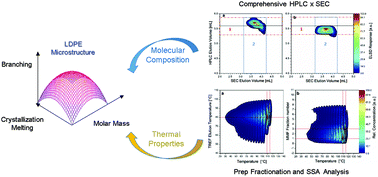当前位置:
X-MOL 学术
›
Polym. Chem.
›
论文详情
Our official English website, www.x-mol.net, welcomes your
feedback! (Note: you will need to create a separate account there.)
Combination of preparative and two-dimensional chromatographic fractionation with thermal analysis for the branching analysis of polyethylene†
Polymer Chemistry ( IF 4.1 ) Pub Date : 2018-05-17 00:00:00 , DOI: 10.1039/c8py00522b Paul S. Eselem Bungu 1, 2, 3, 4 , Kristina Pflug 5, 6, 7, 8 , Harald Pasch 1, 2, 3, 4
Polymer Chemistry ( IF 4.1 ) Pub Date : 2018-05-17 00:00:00 , DOI: 10.1039/c8py00522b Paul S. Eselem Bungu 1, 2, 3, 4 , Kristina Pflug 5, 6, 7, 8 , Harald Pasch 1, 2, 3, 4
Affiliation

|
Low density polyethylene (LDPE) or, more generally, branched polyethylene exhibits excellent processing properties thanks to its complex molecular structure. The branches on the polymer backbone are distributed by location and size and these molecular properties determine the crystalline/amorphous morphology of the crystalline, semi-crystalline and amorphous components. In the present study, the molecular complexity of branched PE is correlated to its thermal properties and morphology. The study follows the multiple fractionation protocol established on a representative LDPE resin, whereby, narrowly dispersed branched fractions having broad molar mass distributions are generated using preparative temperature rising elution fractionation (pTREF). Alternatively, broadly branched fractions having narrow molar mass dispersities are obtained via preparative molar mass fractionation (pMMF). The molecular structure of the fractions and the bulk resin are investigated using solution crystallization analysis by laser light scattering (SCALLS), differential scanning calorimetry (DSC) and successive self-nucleation and annealing fractionation (SSA) to describe the thermal properties and the morphology of the different molecular species. Since these techniques are biased towards the analysis of the crystallisable components, solvent gradient high performance liquid chromatography (HPLC) is used as a complementary technique to account for both the crystalline and amorphous components. A comprehensive two-dimensional liquid chromatography technique coupling HPLC and size exclusion chromatography (SEC) is used to investigate the bivariate distributions of branching and molar mass. SEC-MALLS and SEC-IR5 are used to determine long chain branching and total branching of the fractions and the bulk resin.
中文翻译:

制备和二维色谱分离与热分析相结合,用于聚乙烯的支化分析†
低密度聚乙烯(LDPE)或更普遍的支化聚乙烯由于其复杂的分子结构而具有出色的加工性能。聚合物主链上的支链按位置和大小分布,这些分子特性决定了结晶,半结晶和非晶态组分的结晶/非晶形态。在本研究中,支链PE的分子复杂性与其热性质和形态有关。该研究遵循在代表性的LDPE树脂上建立的多重分馏规程,从而使用制备型升温洗脱分馏(pTREF)生成了具有较宽摩尔质量分布的狭窄分散的支化级分。或者,获得具有较窄摩尔质量分散度的宽支化级分通过制备摩尔质量分数(pMMF)。使用激光散射(SCALLS),差示扫描量热法(DSC)和连续自成核和退火分级分离(SSA)进行溶液结晶分析,研究了级分和本体树脂的分子结构,以描述其热性能和形貌。不同的分子种类。由于这些技术偏向于对可结晶成分的分析,因此溶剂梯度高效液相色谱(HPLC)被用作补充技术,以解决结晶成分和无定形成分的问题。结合液相色谱和尺寸排阻色谱(SEC)的全面二维液相色谱技术用于研究支链和摩尔质量的双变量分布。
更新日期:2018-05-17
中文翻译:

制备和二维色谱分离与热分析相结合,用于聚乙烯的支化分析†
低密度聚乙烯(LDPE)或更普遍的支化聚乙烯由于其复杂的分子结构而具有出色的加工性能。聚合物主链上的支链按位置和大小分布,这些分子特性决定了结晶,半结晶和非晶态组分的结晶/非晶形态。在本研究中,支链PE的分子复杂性与其热性质和形态有关。该研究遵循在代表性的LDPE树脂上建立的多重分馏规程,从而使用制备型升温洗脱分馏(pTREF)生成了具有较宽摩尔质量分布的狭窄分散的支化级分。或者,获得具有较窄摩尔质量分散度的宽支化级分通过制备摩尔质量分数(pMMF)。使用激光散射(SCALLS),差示扫描量热法(DSC)和连续自成核和退火分级分离(SSA)进行溶液结晶分析,研究了级分和本体树脂的分子结构,以描述其热性能和形貌。不同的分子种类。由于这些技术偏向于对可结晶成分的分析,因此溶剂梯度高效液相色谱(HPLC)被用作补充技术,以解决结晶成分和无定形成分的问题。结合液相色谱和尺寸排阻色谱(SEC)的全面二维液相色谱技术用于研究支链和摩尔质量的双变量分布。











































 京公网安备 11010802027423号
京公网安备 11010802027423号